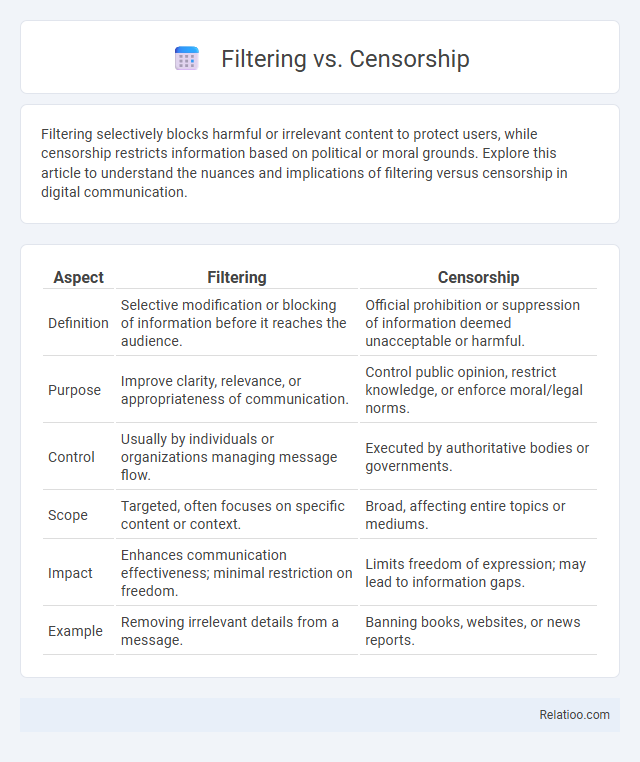Filtering selectively blocks harmful or irrelevant content to protect users, while censorship restricts information based on political or moral grounds. Explore this article to understand the nuances and implications of filtering versus censorship in digital communication.
Table of Comparison
| Aspect | Filtering | Censorship |
|---|---|---|
| Definition | Selective modification or blocking of information before it reaches the audience. | Official prohibition or suppression of information deemed unacceptable or harmful. |
| Purpose | Improve clarity, relevance, or appropriateness of communication. | Control public opinion, restrict knowledge, or enforce moral/legal norms. |
| Control | Usually by individuals or organizations managing message flow. | Executed by authoritative bodies or governments. |
| Scope | Targeted, often focuses on specific content or context. | Broad, affecting entire topics or mediums. |
| Impact | Enhances communication effectiveness; minimal restriction on freedom. | Limits freedom of expression; may lead to information gaps. |
| Example | Removing irrelevant details from a message. | Banning books, websites, or news reports. |
Understanding Filtering and Censorship: Key Differences
Filtering refers to the selective blocking or restricting of specific content based on predefined criteria, allowing users to access most information while protecting against harmful or inappropriate material. Censorship involves authoritative control that suppresses or removes content deemed objectionable by governments or organizations, often limiting freedom of expression and access to information. Understanding the key differences helps you recognize how filtering supports safe browsing environments, while censorship can impact your access to diverse perspectives.
The Purpose and Intent Behind Filtering
Filtering selectively blocks or restricts access to certain content based on predefined criteria to protect users from harmful or inappropriate material. Censorship involves the suppression or control of information by authorities with the intent to limit freedom of expression or control public perception. Your understanding of filtering's purpose is crucial as it aims to safeguard users rather than manipulate or restrict information like censorship does.
Censorship: Motivations and Methods
Censorship involves the suppression of content based on political, moral, or cultural motivations aimed at controlling information flow and maintaining power structures. Governments, corporations, and institutions use methods such as content removal, keyword blocking, and digital surveillance to enforce censorship. Understanding censorship's impact helps Your awareness of information freedom and the forces shaping access to knowledge.
Historical Contexts of Filtering vs Censorship
Filtering and censorship, though often confused, have distinct historical contexts rooted in control over information access versus suppression of content. Historically, filtering emerged as a technological tool aimed at selectively blocking specific content based on predefined criteria, primarily for protecting users from harmful or inappropriate material. Censorship, on the other hand, has been practiced by governments and institutions for centuries to suppress dissent, control public opinion, and maintain social or political power, often involving broader and more overt restrictions on freedom of expression than your typical filtering systems.
Types of Content Typically Filtered
Content filtering primarily targets websites, emails, and social media posts containing explicit adult material, malware, or phishing scams, while censorship involves the broader suppression of political dissent, hate speech, and culturally sensitive topics. Your internet experience may be shaped by filters blocking gambling, violent content, or misinformation, designed to protect minors and maintain workplace productivity. In contrast, censorship often restricts access to news, historical facts, or religious views deemed undesirable by authorities or institutions.
How Governments Implement Censorship
Governments implement censorship by using advanced filtering technologies to block access to specific websites, keywords, and online content deemed politically sensitive or harmful. This process involves real-time monitoring, content analysis, and suppression tools integrated with national internet infrastructure to control information flow. Unlike general filtering for security or productivity, governmental censorship enforces strict regulations and legal frameworks to restrict freedom of expression and manage public perception.
The Impact on Freedom of Expression
Filtering restricts access to specific content based on set criteria, often improving user experience while maintaining a level of choice. Censorship enforces the removal or suppression of information deemed undesirable by authorities, significantly limiting your freedom of expression. Both filtering and censorship shape the digital landscape, but censorship poses a more direct threat to open dialogue and the exchange of ideas.
Filtering Technology: Tools and Techniques
Filtering technology employs advanced tools such as firewalls, DNS filtering, and proxy servers to control and restrict access to specific online content based on predetermined criteria. Techniques like keyword blocking, URL filtering, and packet inspection enable precise content management tailored to organizational policies or user preferences. Your digital environment benefits from these tools by enhancing security, ensuring compliance, and maintaining productivity through selective content control.
Ethical Considerations: Is Filtering Always Censorship?
Filtering involves selectively restricting access to content based on predefined criteria, whereas censorship implies the suppression or prohibition of speech by authoritative entities. Ethical considerations hinge on the intent and context; filtering aims to protect users from harmful or inappropriate material without necessarily infringing on freedom of expression, while censorship often restricts legitimate discourse or dissent. Distinguishing between filtering and censorship requires evaluating transparency, accountability, and respect for users' rights to ensure that filtering mechanisms do not covertly become tools of censorship.
Strategies for Navigating Online Information Controls
Effective strategies for navigating online information controls involve understanding the distinctions between filtering, censorship, and blocking. Filtering selectively restricts access to specific content based on predefined criteria, allowing users to customize their online experience, whereas censorship imposes broader limitations by authorities aiming to suppress information flow. You can enhance your digital freedom by using tools like virtual private networks (VPNs), proxy servers, and encrypted communication channels to bypass filtering and censorship measures while maintaining privacy and security.

Infographic: Filtering vs Censorship
 relatioo.com
relatioo.com